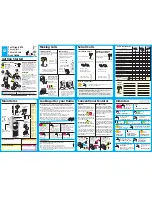
User manual
6
Under
normal
conditions,
the
air
volume
generated
from
the
radiator’s
fan
is
enough
to
meet
the
requirement
of
the
working
room
ventilation.
The
air
inlet
temperature
of
the
engine
shall
be
below
30
degree
Celsius.
If
the
air
inlet
temperature
keep
rising
above
30
degree
Celsius,
the
engine’s
output
power
will
be
reduced,
and
therefore
fresh
air
from
outside
shall
be
introduced
into
the
generator
set’s
working
room
in
a
timely
manner.
If
the
generator
set
is
furnished
with
a
remote
radiator,
forced
air
circulation
for
the
generator
set
working
room
is
a
must.
The
forced
air
circulation
need
two
fans,
one
fan
is
responsible
for
air
intake,
another
is
air
exhaust,
which
exhausts
hot
air
to
outside.
When
the
engine
is
furnished
with
propelled
fan,
it
is
recommended
that
a
separate
pipe
is
needed
to
exhaust
the
gas
which
generated
from
the
crankcase
to
outside.
Otherwise
the
exhaust
gas
from
the
crankcase
will
accumulate
on
the
radiator,
which
will
cause
the
radiator
stuck
by
dirty
material,
and
as
a
result,
the
heat
‐
sinking
capacity
will
be
reduced.
2.5.3
Exhaust
Our
standard
configuration
diesel
generator
sets
provide
accessories
such
as
industry
heavy
silencer,
soft
corrugated
pipe
and
elbow
etc.
Users
can
design
the
exhaust
system
of
generator
set
working
room
by
themselves.
When
design
and
install
the
exhaust
system,
please
consider
the
following
aspects:
◆
Ensure
the
total
exhaust
backpressure
no
higher
than
the
maximum
allowed
value
specified
by
the
engine(usually
generator
set’s
maximum
exhaust
backpressure
is
no
more
than
5Kpa)
Fix
the
exhaust
system
to
make
sure
the
exhaust
manifold
and
turbo
‐
charger
are
not
subject
to
the
vertical
pressure
and
side
stress.
◆
Reserve
some
space
for
hot
shrinkage
and
cold
expansion.
◆
Reserve
space
for
generator
set
vibration.
◆
Reduce
exhaust
noise
level.
Overload
of
exhaust
backpressure
will
cause
following
adverse
effect:
◆
Output
power
loss
◆
Fuel
efficiency
reduce
◆
Exhaust
gas
temperature
rise
Note:
When
more
than
one
generator
set
are
installed,
try
not
to
discharge
all
of
the
generator
sets’
gas
from
one
exhaust
path.
If
no
separated
exhaust
pipe
is
allowed,
under
the
condition
that
the
total
backpressure
will
not
exceed
the
generator
sets’
total
backpressure
a
moveable
separate
panel
shall
be
installed
inside
of
the
branch
exhaust
pipe
so
that
to
prevent
the
gas
from
return.
In
the
exhaust
system,
soft
corrugated
pipe
shall
be
used
to
connect
the
exhaust
pipe
with
the
turbocharger,
this
pipe
has
three
functions
as
follows:
◆
Separate
the
diesel
engine
with
vibration
and
the
weight
of
exhaust
pipe.
◆
Compensate
the
heat
expansion
of
exhaust
pipe.
If
the
diesel
generator
set
is
installed
on
the
anti
‐
vibration
base
frame,
the
corrugated
pipe
can
compensate
sideway
movement
when
engine
start
or
stop.
Note:
1.
Serious
damage
will
occur
when
rain
or
condensed
water
enter
into
engine’s
exhaust
system.
Therefore,
one
water
discharge
opening
shall
be
installed
in
the
long
exhaust
pipe,
the
position
of
which
shall
be
close
to
the
generator
set.
2.
When
the
top
of
the
exhaust
pipe
is
above
the
architecture,
lightening
protection
is
needed
(connect
to
the
ground)
2.5.4
Noise
reduction
When
diesel
generator
set
is
running,
normally
it
will
generate
noise
level
of
90
~
110dB,
and
the
more
the
load,
the
higher
the
noise
level.
In
order
to
meet
the
noise
level
standards
established
by
the
local
environmental
protection
bureau
and
to
prevent
the
noise
pollution
caused
to
ambient
environment,
which
will
affect
people’s
normal
life,
to
reduce
noise
level
of
diesel
generator
set
is
also
Summary of Contents for DHY11KSE
Page 1: ...Diesel Generator User Manual...
Page 2: ......
Page 27: ......
Page 28: ......
Page 29: ......
Page 30: ......
Page 31: ......
Page 32: ......
Page 33: ......
Page 34: ......
Page 35: ...DHY10KE KSE DHY250KE KSE...
Page 36: ...DHY10KE KSE DHY250KE KSE...
Page 37: ...DHY10KE KSE DHY250KE KSE...
Page 38: ...DHY10KE KSE DHY250KE KSE...
Page 39: ...DHY10KE KSE DHY250KE KSE...
Page 40: ...DHY10KE KSE DHY250KE KSE...
Page 41: ...APPENDIX E 1...
Page 42: ...2...
Page 43: ...3...
Page 46: ...APPENDIX H...
Page 47: ......













































